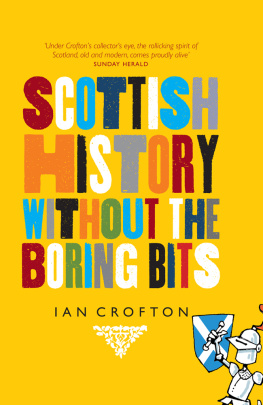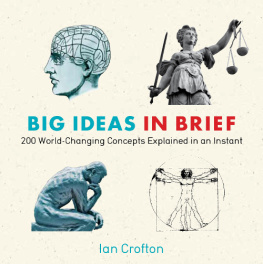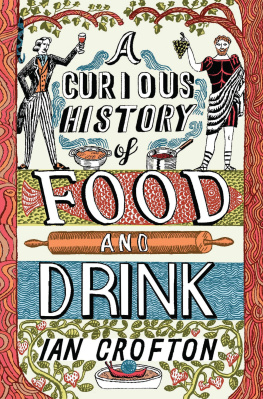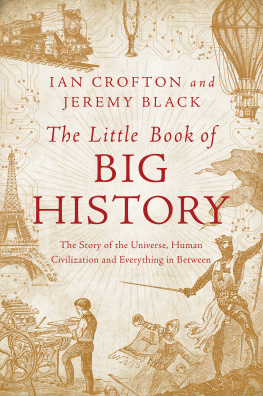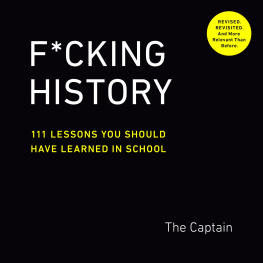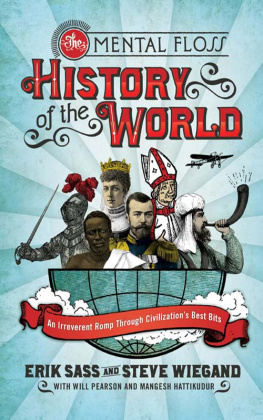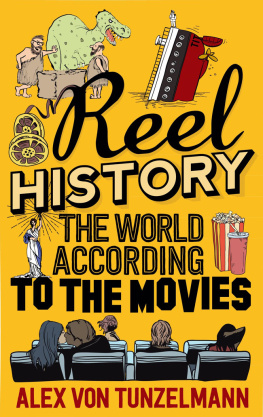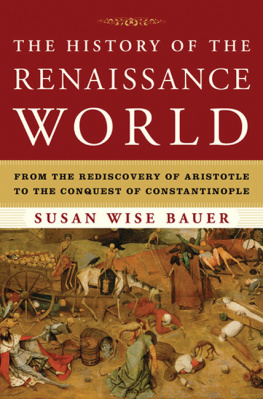Contents
FROM ANCIENT TIMES TO THE MIDDLE AGES
OTHER WORLDS
THE EARLY MODERN PERIOD
GATHERING PACE
THE 20TH CENTURY AND AFTER
events
you really need to know
world history
Ian Crofton

New York London
2011 by Ian Crofton
All rights reserved. No part of this book may be reproduced in any form or by any electronic or mechanical means, including information storage and retrieval systems, without permission in writing from the publisher, except by reviewers, who may quote brief passages in a review. Scanning, uploading, and electronic distribution of this book or the facilitation of the same without the permission of the publisher is prohibited.
Please purchase only authorized electronic editions, and do not participate in or encourage electronic piracy of copyrighted materials. Your support of the authors rights is appreciated.
Any member of educational institutions wishing to photocopy part or all of the work for classroom use or anthology should send inquiries to Permissions c/o Quercus Publishing Inc., 31 West 57th Street, 6th Floor, New York, NY 10019, or to .
ISBN 978-1-62365-194-7
Distributed in the United States and Canada by Random House Publisher Services
c/o Random House, 1745 Broadway
New York, NY 10019
www.quercus.com
Introduction
Many will no doubt regard it as insufferably presumptuous to claim that the history of the world can be compressed into so short a book as this. Even short histories of the world are usually much longer. But the aim here is not to provide an overarching survey of the story of humanity, but to focus on certain key developments and events, so providing some very basic foundations for the reader to build on if he or she so wishes.
It is a common complaint that children are only taught a handful of historical topics at schoolthe Romans, the Tudors, the Nazis, for exampleand have no idea about all the bits in between. This book does not claim to fill in all those bits in between, but it does aim to broaden horizons and to introduce the reader to topics of which he or she may only have had the littlest inkling.
There are many lenses through which one can examine the past. Recent decades have seen a blossoming of a variety of approaches that cut across the stories we traditionally told ourselves about how we got to where we aresocial history, economic history, black history, the histories of labor, of women, of ideas, to name but a few. To exponents of these disciplines, the present volume will no doubt appear terribly old-fashioned, with its chronicles of wars, empires, conquerors, discoveries, and so on. But this book aspires to be more than a bald and unconsidered account in which one event simply follows another, without explanation. Economic, social, geographic, cultural and other factors are all considered, and it is hoped that the reader will come away with some flavor of the complexities and uncertainties involved in attempting to understand the past, and how it might or might not color the way we live now.
Ian Crofton
The beginnings of agriculture
None of the things that we take today as marks of our civilizationour great cities, our art, music and literature, our commerce and industry, our scientific and technological achievementswould be possible without agriculture.
It was only after we human beings learned how to farm that we could produce sufficient food surpluses to allow some of us to follow pursuits other than hunting and gathering. With some people specializing in food production, others could become full-time priests or soldiers or artisans or scribes or scholars. Thus more complex, and less egalitarian, societies began to emerge. But these developments only came very late in the story of humankind.
The dawn of humanity The earliest of our ancestors that we might recognize as human emerged some 4 million years ago. Over the ages a variety of human species evolvedHomo habilis, Homo erectus, the Neanderthalsbut it was not until around 100,000 years ago that modern humans began to spread out of Africa and started to colonize the rest of the world.
Humans had started to use stone tools around 2 million years previously, but the rate of technological progress was extremely slow. Gradually tools and weaponsof wood, stone, bone and antlerbecame more refined, and humans learned how to use fire. People sustained themselves by fishing, hunting and gathering fruits, seeds, nuts and berriesa way of life that can support small groups, but which requires that the hunter-gatherers must move on once the resources of one area are temporarily exhausted.
Then around 8000 BC something extraordinary happened in the Fertile Crescent, an area of the Middle East that extends from the valleys of the Tigris and Euphrates rivers westward through Syria and then south through the Levant. It was here that people first began to cultivate crops, kick-starting a global revolution in the way that humans live. The Fertile Crescent was the first but not the only area to experience an agricultural revolution: farming independently began in various other parts of the world, including Mesoamerica, the Andean region of South America, China, southeast Asia and sub-Saharan Africa.
And Abel was a keeper of sheep, but Cain was a tiller of the ground.
Genesis, 4:2, on the sons of Adam and Eve
The first crops It is probably no coincidence that the beginnings of agriculture 10,000 years ago coincided with the end of the last Ice Age. As the earth warmed, the ice sheets covering much of northern Eurasia and North America melted, releasing vast amounts of fresh water. In these conditions, the sparse tundra gave way to lusher vegetationgrasslands and forestswhich provided hunter-gatherers with much richer pickings. In some places, the environment was so productive that groups that knew how to exploit it could stay put rather than having to move on constantly. With greater quantities of food available, populations grew, and this in turn meant that people had to devise ways of surviving through leaner periods, by learning how to store food. One of the easiest foods to store, because they do not decay when kept dry, are cerealsthe seeds of various grasses.
It was no doubt a gradual process by which certain groups learned to look after the wild plants that they found most useful as food sources. Keeping off pests and clearing away weeds was a start, and at some point people made the connection between sowing seed and harvesting the resulting crop. In the Fertile Crescent, wheat and barley were the key cereals; in the Americas it was maize, in sub-Saharan Africa sorghum, in northern China millet, while in southern China and southeast Asia it was rice. Other crops were also important in various parts of the world, for example beans, yams, potatoes, gourds and peppers.
A hidden danger
Reliance on a diet of cereals contained a hidden danger. Many skeletons from the ancient world show evidence of appalling abscesses in the jaw, a result of teeth shattering when biting on fragments of rock from the stones used to grind the grain.


